Patient Care Service Redesign: Evaluation and Improvement Analysis
VerifiedAdded on 2023/06/10
|16
|3329
|313
Report
AI Summary
This report evaluates and proposes improvements to patient care services within a healthcare organization, focusing on reducing waiting times and enhancing patient satisfaction. It highlights the challenges faced by the National Health Service (NHS) due to increasing service demands and reduced funding. The report employs tools like SWOT analysis and process mapping to assess the current service delivery, particularly within the general X-Ray department. It identifies bottlenecks, such as the FIFO system and prioritization issues between General Practitioner and Orthopaedic patients. The report then explores various options for improvement, including teamwork-based approaches and the introduction of new DR rooms, justifying the preferred option based on performance indicators and cost-effectiveness. Ultimately, the goal is to streamline patient journeys, improve staff morale, and enhance the overall quality of patient care. Desklib provides access to similar past papers and solved assignments for students.

qwertyuiopasdfghjklzxcvbnmqw
ertyuiopasdfghjklzxcvbnmqwert
yuiopasdfghjklzxcvbnmqwertyui
opasdfghjklzxcvbnmqwertyuiop
asdfghjklzxcvbnmqwertyuiopasd
fghjklzxcvbnmqwertyuiopasdfgh
jklzxcvbnmqwertyuiopasdfghjkl
zxcvbnmqwertyuiopasdfghjklzxc
vbnmqwertyuiopasdfghjklzxcvb
nmqwertyuiopasdfghjklzxcvbnm
qwertyuiopasdfghjklzxcvbnmqw
ertyuiopasdfghjklzxcvbnmqwert
yuiopasdfghjklzxcvbnmqwertyui
opasdfghjklzxcvbnmqwertyuiop
asdfghjklzxcvbnmqwertyuiopasd
fghjklzxcvbnmqwertyuiopasdfgh
jklzxcvbnmrtyuiopasdfghjklzxcv
Project Name
ertyuiopasdfghjklzxcvbnmqwert
yuiopasdfghjklzxcvbnmqwertyui
opasdfghjklzxcvbnmqwertyuiop
asdfghjklzxcvbnmqwertyuiopasd
fghjklzxcvbnmqwertyuiopasdfgh
jklzxcvbnmqwertyuiopasdfghjkl
zxcvbnmqwertyuiopasdfghjklzxc
vbnmqwertyuiopasdfghjklzxcvb
nmqwertyuiopasdfghjklzxcvbnm
qwertyuiopasdfghjklzxcvbnmqw
ertyuiopasdfghjklzxcvbnmqwert
yuiopasdfghjklzxcvbnmqwertyui
opasdfghjklzxcvbnmqwertyuiop
asdfghjklzxcvbnmqwertyuiopasd
fghjklzxcvbnmqwertyuiopasdfgh
jklzxcvbnmrtyuiopasdfghjklzxcv
Project Name
Paraphrase This Document
Need a fresh take? Get an instant paraphrase of this document with our AI Paraphraser
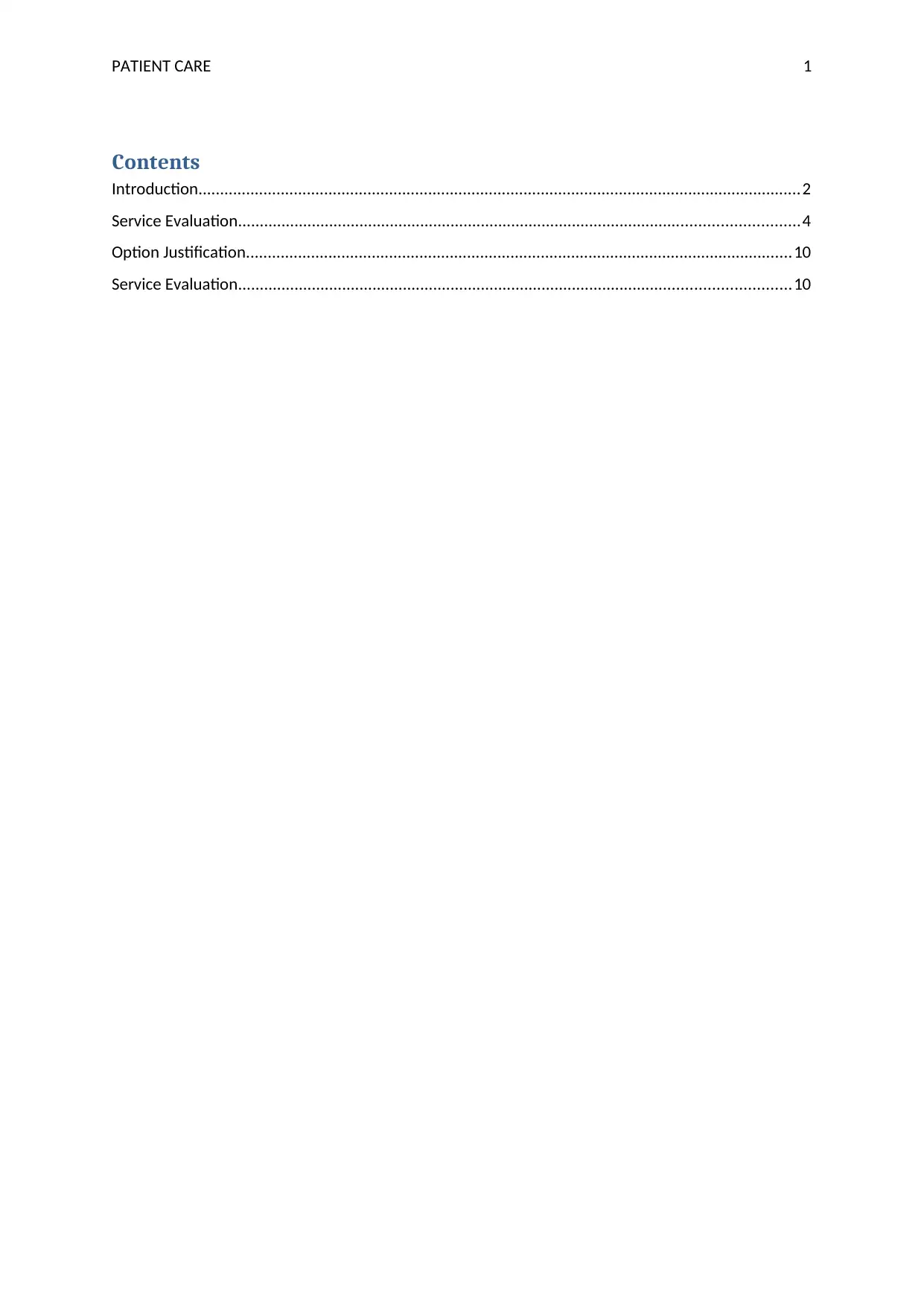
PATIENT CARE 1
Contents
Introduction...........................................................................................................................................2
Service Evaluation.................................................................................................................................4
Option Justification..............................................................................................................................10
Service Evaluation...............................................................................................................................10
Contents
Introduction...........................................................................................................................................2
Service Evaluation.................................................................................................................................4
Option Justification..............................................................................................................................10
Service Evaluation...............................................................................................................................10
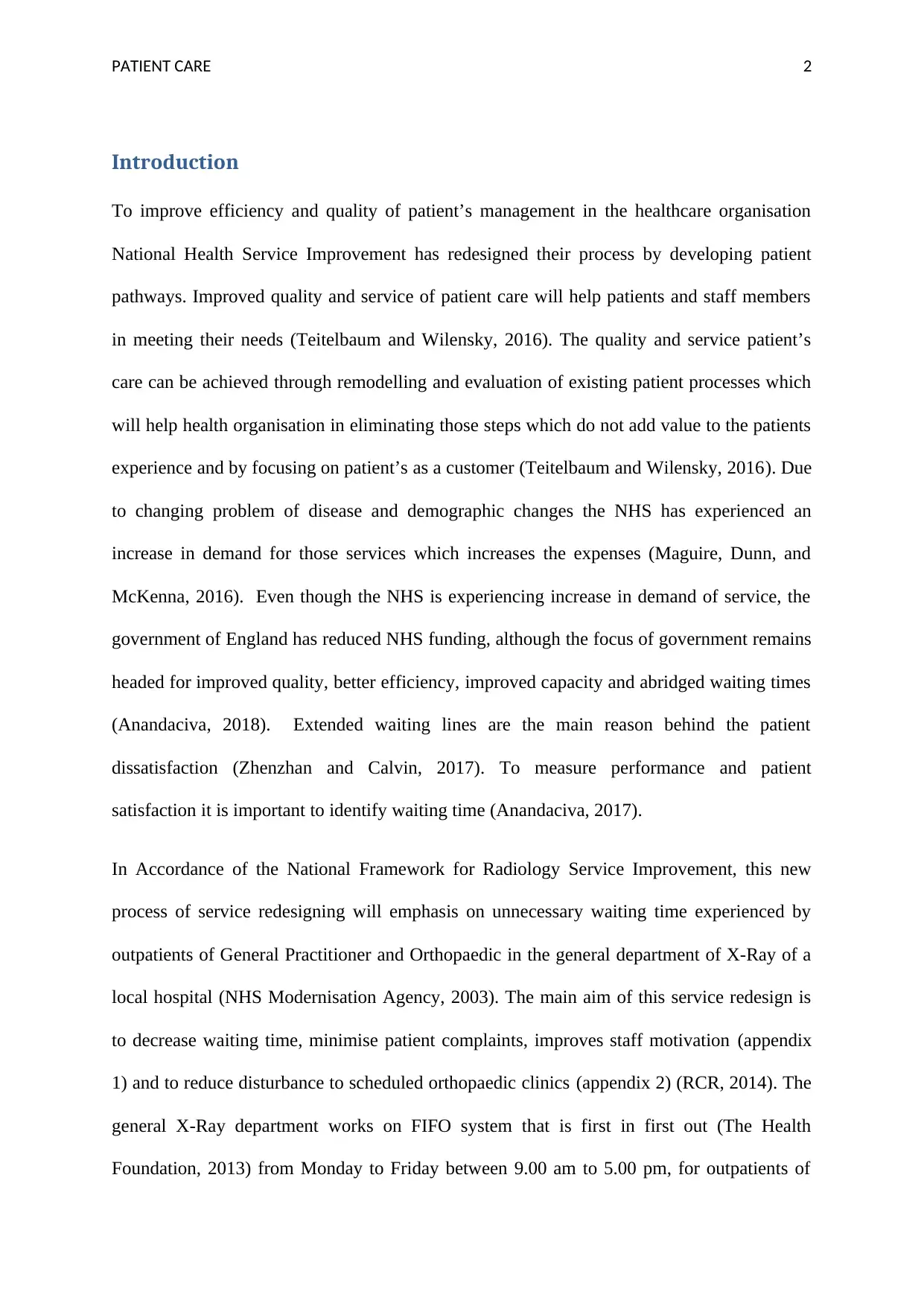
PATIENT CARE 2
Introduction
To improve efficiency and quality of patient’s management in the healthcare organisation
National Health Service Improvement has redesigned their process by developing patient
pathways. Improved quality and service of patient care will help patients and staff members
in meeting their needs (Teitelbaum and Wilensky, 2016). The quality and service patient’s
care can be achieved through remodelling and evaluation of existing patient processes which
will help health organisation in eliminating those steps which do not add value to the patients
experience and by focusing on patient’s as a customer (Teitelbaum and Wilensky, 2016). Due
to changing problem of disease and demographic changes the NHS has experienced an
increase in demand for those services which increases the expenses (Maguire, Dunn, and
McKenna, 2016). Even though the NHS is experiencing increase in demand of service, the
government of England has reduced NHS funding, although the focus of government remains
headed for improved quality, better efficiency, improved capacity and abridged waiting times
(Anandaciva, 2018). Extended waiting lines are the main reason behind the patient
dissatisfaction (Zhenzhan and Calvin, 2017). To measure performance and patient
satisfaction it is important to identify waiting time (Anandaciva, 2017).
In Accordance of the National Framework for Radiology Service Improvement, this new
process of service redesigning will emphasis on unnecessary waiting time experienced by
outpatients of General Practitioner and Orthopaedic in the general department of X-Ray of a
local hospital (NHS Modernisation Agency, 2003). The main aim of this service redesign is
to decrease waiting time, minimise patient complaints, improves staff motivation (appendix
1) and to reduce disturbance to scheduled orthopaedic clinics (appendix 2) (RCR, 2014). The
general X-Ray department works on FIFO system that is first in first out (The Health
Foundation, 2013) from Monday to Friday between 9.00 am to 5.00 pm, for outpatients of
Introduction
To improve efficiency and quality of patient’s management in the healthcare organisation
National Health Service Improvement has redesigned their process by developing patient
pathways. Improved quality and service of patient care will help patients and staff members
in meeting their needs (Teitelbaum and Wilensky, 2016). The quality and service patient’s
care can be achieved through remodelling and evaluation of existing patient processes which
will help health organisation in eliminating those steps which do not add value to the patients
experience and by focusing on patient’s as a customer (Teitelbaum and Wilensky, 2016). Due
to changing problem of disease and demographic changes the NHS has experienced an
increase in demand for those services which increases the expenses (Maguire, Dunn, and
McKenna, 2016). Even though the NHS is experiencing increase in demand of service, the
government of England has reduced NHS funding, although the focus of government remains
headed for improved quality, better efficiency, improved capacity and abridged waiting times
(Anandaciva, 2018). Extended waiting lines are the main reason behind the patient
dissatisfaction (Zhenzhan and Calvin, 2017). To measure performance and patient
satisfaction it is important to identify waiting time (Anandaciva, 2017).
In Accordance of the National Framework for Radiology Service Improvement, this new
process of service redesigning will emphasis on unnecessary waiting time experienced by
outpatients of General Practitioner and Orthopaedic in the general department of X-Ray of a
local hospital (NHS Modernisation Agency, 2003). The main aim of this service redesign is
to decrease waiting time, minimise patient complaints, improves staff motivation (appendix
1) and to reduce disturbance to scheduled orthopaedic clinics (appendix 2) (RCR, 2014). The
general X-Ray department works on FIFO system that is first in first out (The Health
Foundation, 2013) from Monday to Friday between 9.00 am to 5.00 pm, for outpatients of
⊘ This is a preview!⊘
Do you want full access?
Subscribe today to unlock all pages.

Trusted by 1+ million students worldwide
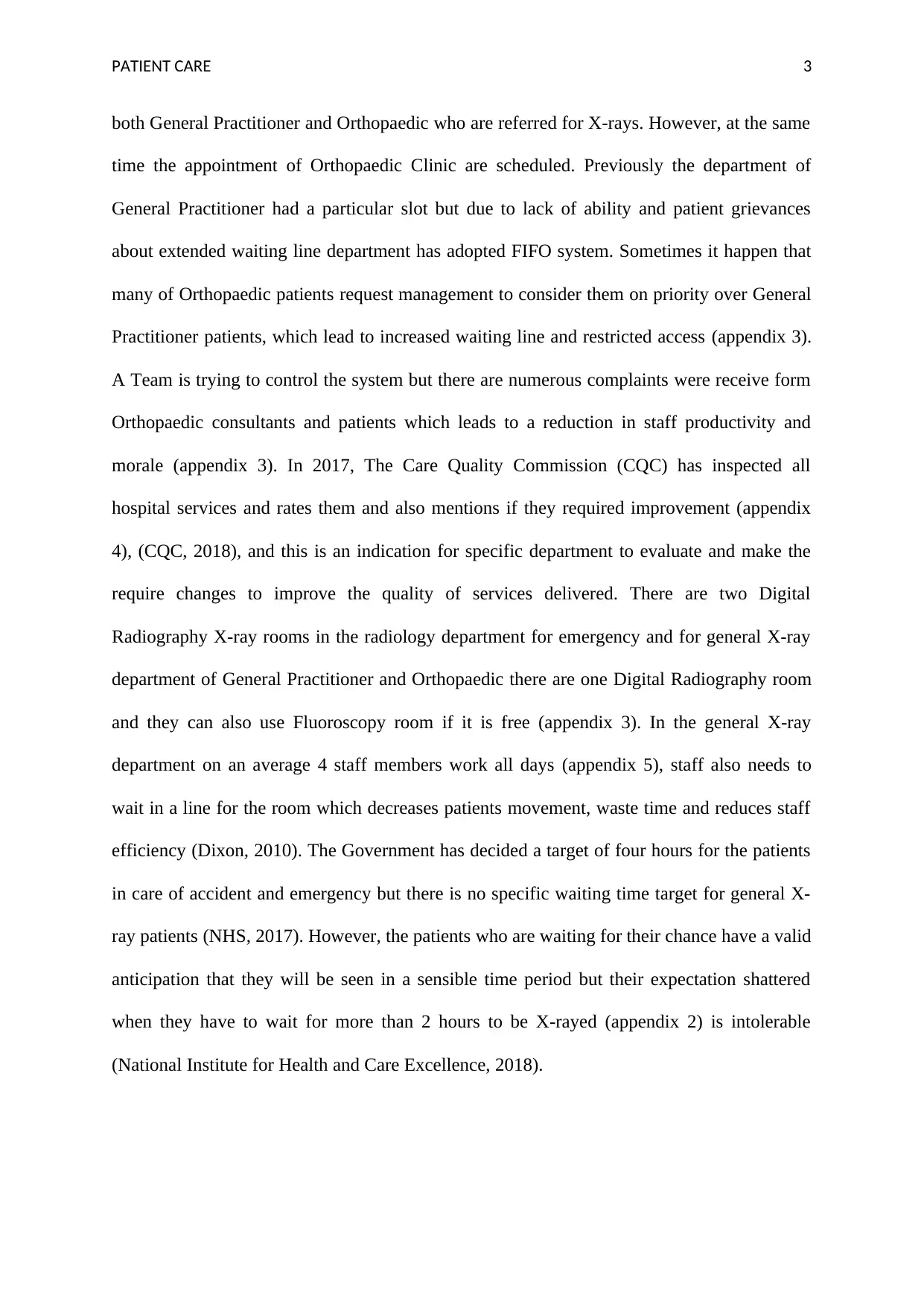
PATIENT CARE 3
both General Practitioner and Orthopaedic who are referred for X-rays. However, at the same
time the appointment of Orthopaedic Clinic are scheduled. Previously the department of
General Practitioner had a particular slot but due to lack of ability and patient grievances
about extended waiting line department has adopted FIFO system. Sometimes it happen that
many of Orthopaedic patients request management to consider them on priority over General
Practitioner patients, which lead to increased waiting line and restricted access (appendix 3).
A Team is trying to control the system but there are numerous complaints were receive form
Orthopaedic consultants and patients which leads to a reduction in staff productivity and
morale (appendix 3). In 2017, The Care Quality Commission (CQC) has inspected all
hospital services and rates them and also mentions if they required improvement (appendix
4), (CQC, 2018), and this is an indication for specific department to evaluate and make the
require changes to improve the quality of services delivered. There are two Digital
Radiography X-ray rooms in the radiology department for emergency and for general X-ray
department of General Practitioner and Orthopaedic there are one Digital Radiography room
and they can also use Fluoroscopy room if it is free (appendix 3). In the general X-ray
department on an average 4 staff members work all days (appendix 5), staff also needs to
wait in a line for the room which decreases patients movement, waste time and reduces staff
efficiency (Dixon, 2010). The Government has decided a target of four hours for the patients
in care of accident and emergency but there is no specific waiting time target for general X-
ray patients (NHS, 2017). However, the patients who are waiting for their chance have a valid
anticipation that they will be seen in a sensible time period but their expectation shattered
when they have to wait for more than 2 hours to be X-rayed (appendix 2) is intolerable
(National Institute for Health and Care Excellence, 2018).
both General Practitioner and Orthopaedic who are referred for X-rays. However, at the same
time the appointment of Orthopaedic Clinic are scheduled. Previously the department of
General Practitioner had a particular slot but due to lack of ability and patient grievances
about extended waiting line department has adopted FIFO system. Sometimes it happen that
many of Orthopaedic patients request management to consider them on priority over General
Practitioner patients, which lead to increased waiting line and restricted access (appendix 3).
A Team is trying to control the system but there are numerous complaints were receive form
Orthopaedic consultants and patients which leads to a reduction in staff productivity and
morale (appendix 3). In 2017, The Care Quality Commission (CQC) has inspected all
hospital services and rates them and also mentions if they required improvement (appendix
4), (CQC, 2018), and this is an indication for specific department to evaluate and make the
require changes to improve the quality of services delivered. There are two Digital
Radiography X-ray rooms in the radiology department for emergency and for general X-ray
department of General Practitioner and Orthopaedic there are one Digital Radiography room
and they can also use Fluoroscopy room if it is free (appendix 3). In the general X-ray
department on an average 4 staff members work all days (appendix 5), staff also needs to
wait in a line for the room which decreases patients movement, waste time and reduces staff
efficiency (Dixon, 2010). The Government has decided a target of four hours for the patients
in care of accident and emergency but there is no specific waiting time target for general X-
ray patients (NHS, 2017). However, the patients who are waiting for their chance have a valid
anticipation that they will be seen in a sensible time period but their expectation shattered
when they have to wait for more than 2 hours to be X-rayed (appendix 2) is intolerable
(National Institute for Health and Care Excellence, 2018).
Paraphrase This Document
Need a fresh take? Get an instant paraphrase of this document with our AI Paraphraser
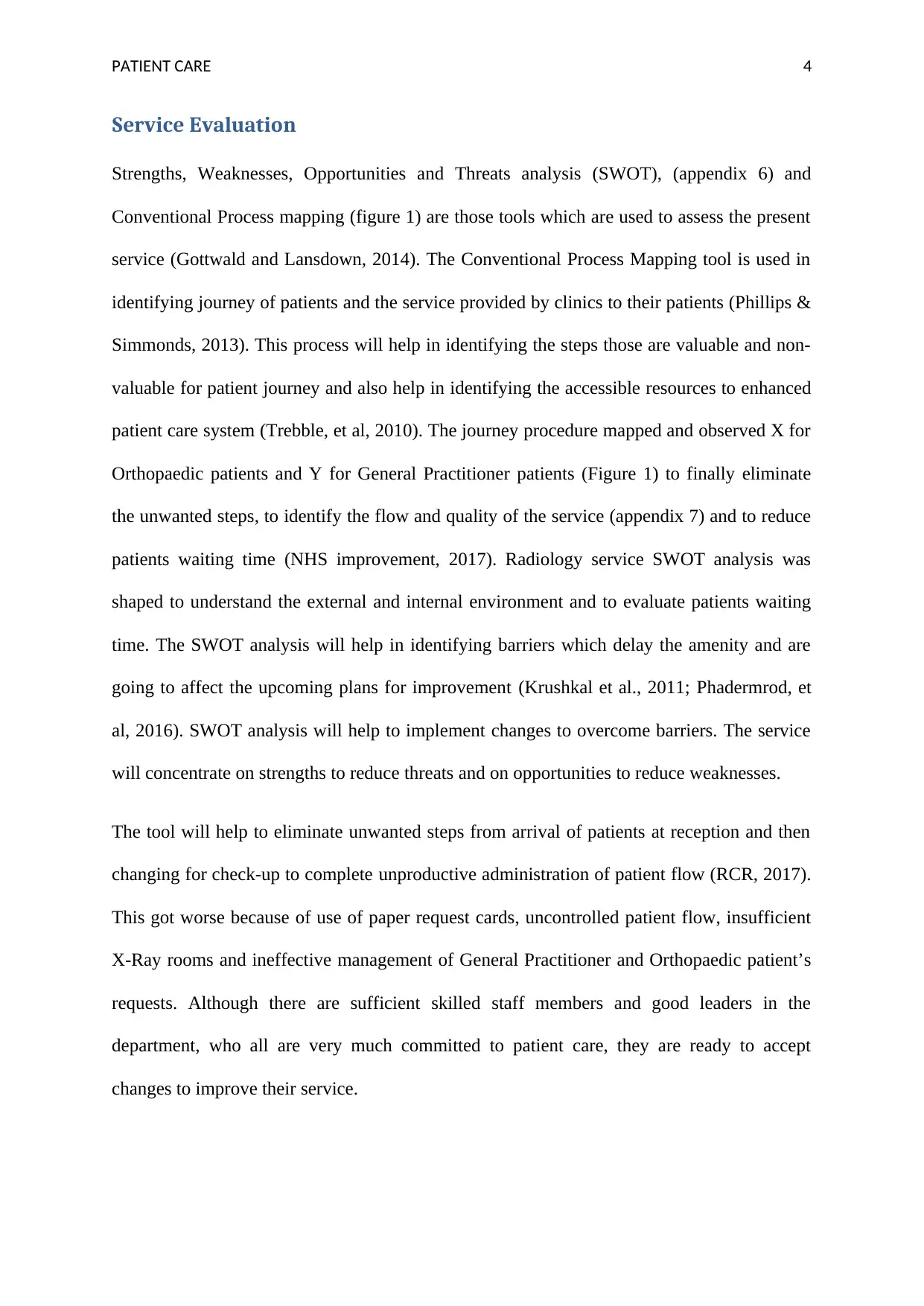
PATIENT CARE 4
Service Evaluation
Strengths, Weaknesses, Opportunities and Threats analysis (SWOT), (appendix 6) and
Conventional Process mapping (figure 1) are those tools which are used to assess the present
service (Gottwald and Lansdown, 2014). The Conventional Process Mapping tool is used in
identifying journey of patients and the service provided by clinics to their patients (Phillips &
Simmonds, 2013). This process will help in identifying the steps those are valuable and non-
valuable for patient journey and also help in identifying the accessible resources to enhanced
patient care system (Trebble, et al, 2010). The journey procedure mapped and observed X for
Orthopaedic patients and Y for General Practitioner patients (Figure 1) to finally eliminate
the unwanted steps, to identify the flow and quality of the service (appendix 7) and to reduce
patients waiting time (NHS improvement, 2017). Radiology service SWOT analysis was
shaped to understand the external and internal environment and to evaluate patients waiting
time. The SWOT analysis will help in identifying barriers which delay the amenity and are
going to affect the upcoming plans for improvement (Krushkal et al., 2011; Phadermrod, et
al, 2016). SWOT analysis will help to implement changes to overcome barriers. The service
will concentrate on strengths to reduce threats and on opportunities to reduce weaknesses.
The tool will help to eliminate unwanted steps from arrival of patients at reception and then
changing for check-up to complete unproductive administration of patient flow (RCR, 2017).
This got worse because of use of paper request cards, uncontrolled patient flow, insufficient
X-Ray rooms and ineffective management of General Practitioner and Orthopaedic patient’s
requests. Although there are sufficient skilled staff members and good leaders in the
department, who all are very much committed to patient care, they are ready to accept
changes to improve their service.
Service Evaluation
Strengths, Weaknesses, Opportunities and Threats analysis (SWOT), (appendix 6) and
Conventional Process mapping (figure 1) are those tools which are used to assess the present
service (Gottwald and Lansdown, 2014). The Conventional Process Mapping tool is used in
identifying journey of patients and the service provided by clinics to their patients (Phillips &
Simmonds, 2013). This process will help in identifying the steps those are valuable and non-
valuable for patient journey and also help in identifying the accessible resources to enhanced
patient care system (Trebble, et al, 2010). The journey procedure mapped and observed X for
Orthopaedic patients and Y for General Practitioner patients (Figure 1) to finally eliminate
the unwanted steps, to identify the flow and quality of the service (appendix 7) and to reduce
patients waiting time (NHS improvement, 2017). Radiology service SWOT analysis was
shaped to understand the external and internal environment and to evaluate patients waiting
time. The SWOT analysis will help in identifying barriers which delay the amenity and are
going to affect the upcoming plans for improvement (Krushkal et al., 2011; Phadermrod, et
al, 2016). SWOT analysis will help to implement changes to overcome barriers. The service
will concentrate on strengths to reduce threats and on opportunities to reduce weaknesses.
The tool will help to eliminate unwanted steps from arrival of patients at reception and then
changing for check-up to complete unproductive administration of patient flow (RCR, 2017).
This got worse because of use of paper request cards, uncontrolled patient flow, insufficient
X-Ray rooms and ineffective management of General Practitioner and Orthopaedic patient’s
requests. Although there are sufficient skilled staff members and good leaders in the
department, who all are very much committed to patient care, they are ready to accept
changes to improve their service.
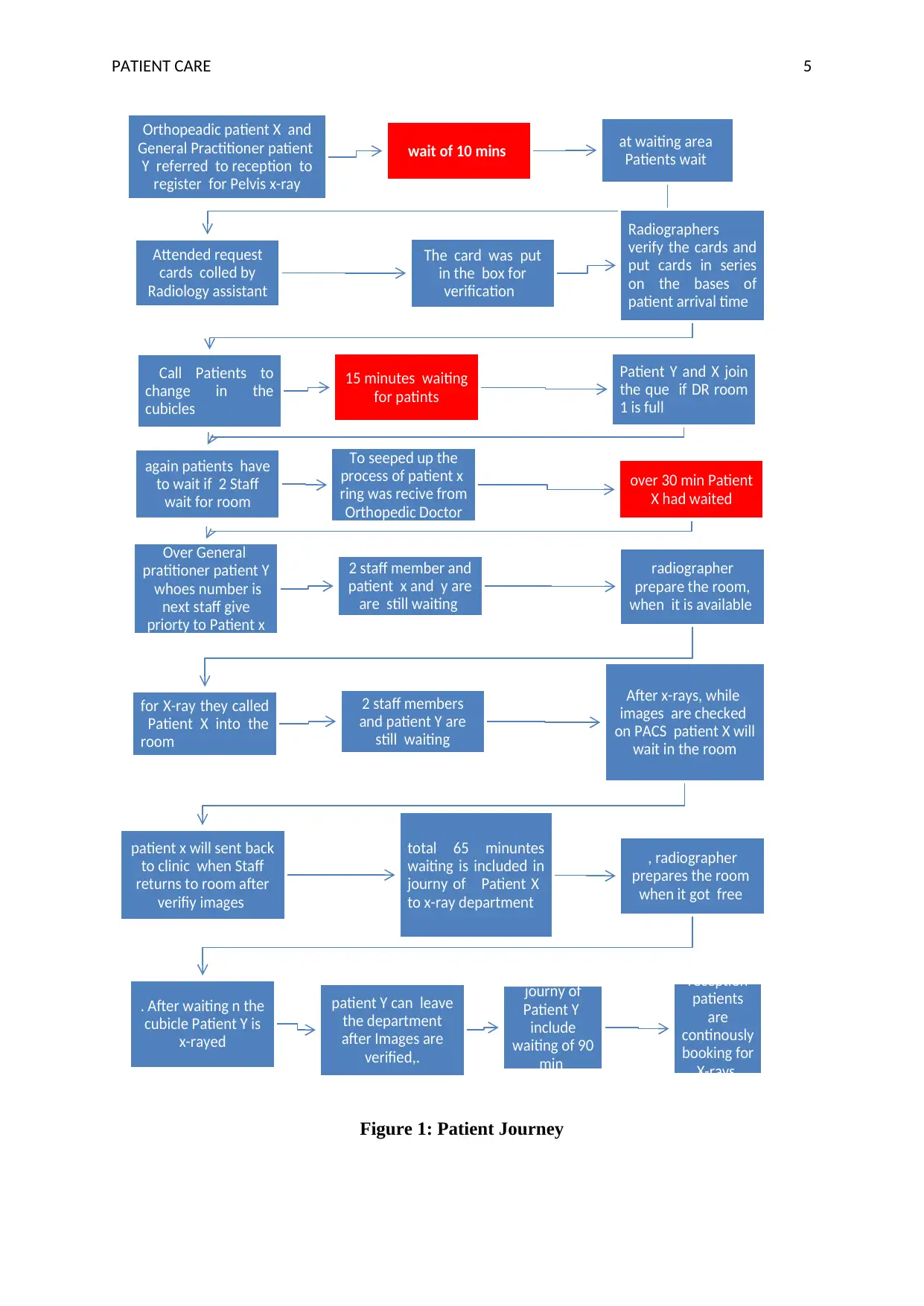
PATIENT CARE 5
Figure 1: Patient Journey
Orthopeadic patient X and
General Practitioner patient
Y referred to reception to
register for Pelvis x-ray
wait of 10 mins at waiting area
Patients wait
Attended request
cards colled by
Radiology assistant
The card was put
in the box for
verification
Radiographers
verify the cards and
put cards in series
on the bases of
patient arrival time
Call Patients to
change in the
cubicles
15 minutes waiting
for patints
Patient Y and X join
the que if DR room
1 is full
again patients have
to wait if 2 Staff
wait for room
To seeped up the
process of patient x
ring was recive from
Orthopedic Doctor
over 30 min Patient
X had waited
Over General
pratitioner patient Y
whoes number is
next staff give
priorty to Patient x
2 staff member and
patient x and y are
are still waiting
radiographer
prepare the room,
when it is available
for X-ray they called
Patient X into the
room
2 staff members
and patient Y are
still waiting
After x-rays, while
images are checked
on PACS patient X will
wait in the room
patient x will sent back
to clinic when Staff
returns to room after
verifiy images
total 65 minuntes
waiting is included in
journy of Patient X
to x-ray department
, radiographer
prepares the room
when it got free
. After waiting n the
cubicle Patient Y is
x-rayed
patient Y can leave
the department
after Images are
verified,.
journy of
Patient Y
include
waiting of 90
min
At
reception
patients
are
continously
booking for
X-rays.
Figure 1: Patient Journey
Orthopeadic patient X and
General Practitioner patient
Y referred to reception to
register for Pelvis x-ray
wait of 10 mins at waiting area
Patients wait
Attended request
cards colled by
Radiology assistant
The card was put
in the box for
verification
Radiographers
verify the cards and
put cards in series
on the bases of
patient arrival time
Call Patients to
change in the
cubicles
15 minutes waiting
for patints
Patient Y and X join
the que if DR room
1 is full
again patients have
to wait if 2 Staff
wait for room
To seeped up the
process of patient x
ring was recive from
Orthopedic Doctor
over 30 min Patient
X had waited
Over General
pratitioner patient Y
whoes number is
next staff give
priorty to Patient x
2 staff member and
patient x and y are
are still waiting
radiographer
prepare the room,
when it is available
for X-ray they called
Patient X into the
room
2 staff members
and patient Y are
still waiting
After x-rays, while
images are checked
on PACS patient X will
wait in the room
patient x will sent back
to clinic when Staff
returns to room after
verifiy images
total 65 minuntes
waiting is included in
journy of Patient X
to x-ray department
, radiographer
prepares the room
when it got free
. After waiting n the
cubicle Patient Y is
x-rayed
patient Y can leave
the department
after Images are
verified,.
journy of
Patient Y
include
waiting of 90
min
At
reception
patients
are
continously
booking for
X-rays.
⊘ This is a preview!⊘
Do you want full access?
Subscribe today to unlock all pages.

Trusted by 1+ million students worldwide
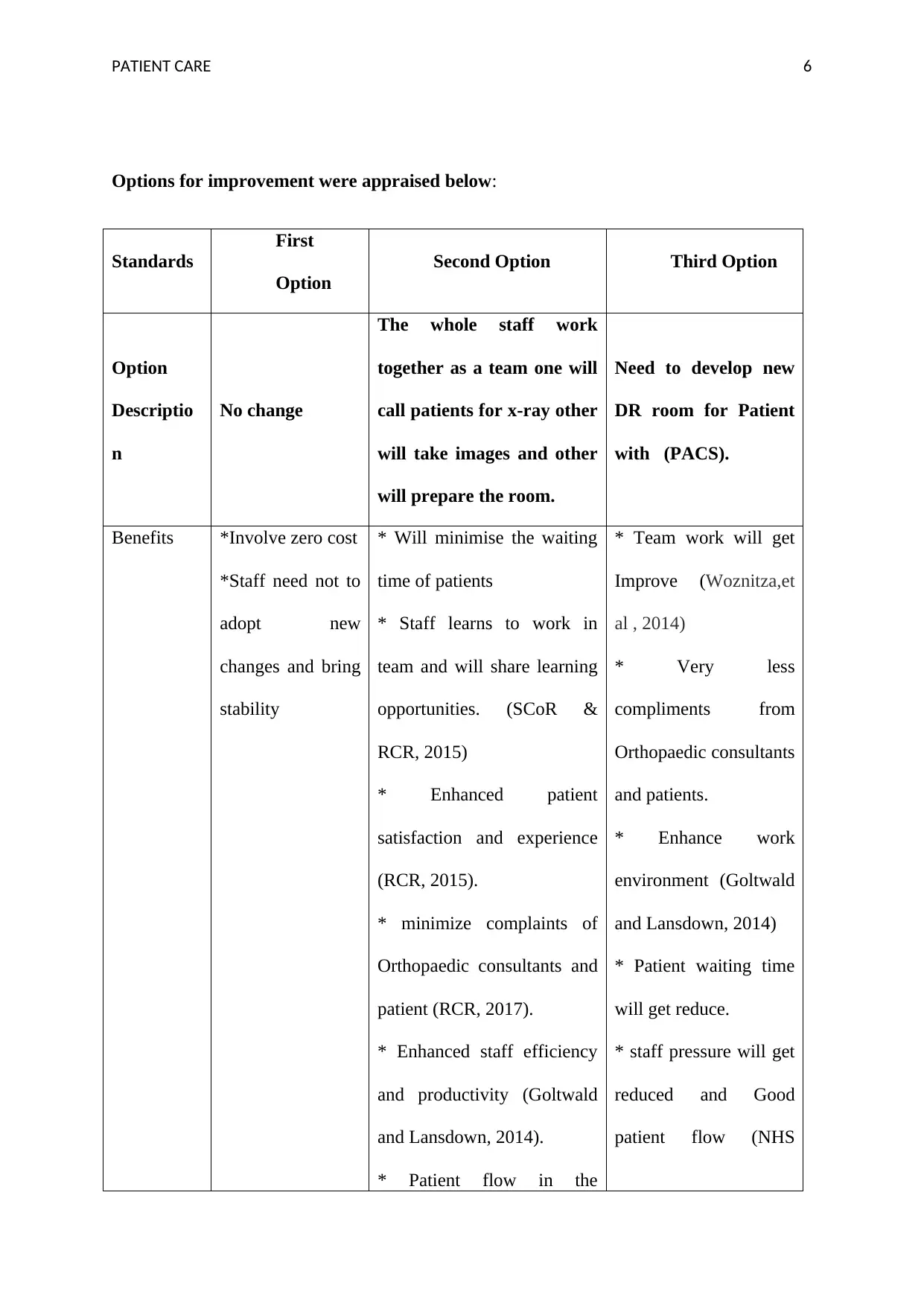
PATIENT CARE 6
Options for improvement were appraised below:
Standards
First
Option
Second Option Third Option
Option
Descriptio
n
No change
The whole staff work
together as a team one will
call patients for x-ray other
will take images and other
will prepare the room.
Need to develop new
DR room for Patient
with (PACS).
Benefits *Involve zero cost
*Staff need not to
adopt new
changes and bring
stability
* Will minimise the waiting
time of patients
* Staff learns to work in
team and will share learning
opportunities. (SCoR &
RCR, 2015)
* Enhanced patient
satisfaction and experience
(RCR, 2015).
* minimize complaints of
Orthopaedic consultants and
patient (RCR, 2017).
* Enhanced staff efficiency
and productivity (Goltwald
and Lansdown, 2014).
* Patient flow in the
* Team work will get
Improve (Woznitza,et
al , 2014)
* Very less
compliments from
Orthopaedic consultants
and patients.
* Enhance work
environment (Goltwald
and Lansdown, 2014)
* Patient waiting time
will get reduce.
* staff pressure will get
reduced and Good
patient flow (NHS
Options for improvement were appraised below:
Standards
First
Option
Second Option Third Option
Option
Descriptio
n
No change
The whole staff work
together as a team one will
call patients for x-ray other
will take images and other
will prepare the room.
Need to develop new
DR room for Patient
with (PACS).
Benefits *Involve zero cost
*Staff need not to
adopt new
changes and bring
stability
* Will minimise the waiting
time of patients
* Staff learns to work in
team and will share learning
opportunities. (SCoR &
RCR, 2015)
* Enhanced patient
satisfaction and experience
(RCR, 2015).
* minimize complaints of
Orthopaedic consultants and
patient (RCR, 2017).
* Enhanced staff efficiency
and productivity (Goltwald
and Lansdown, 2014).
* Patient flow in the
* Team work will get
Improve (Woznitza,et
al , 2014)
* Very less
compliments from
Orthopaedic consultants
and patients.
* Enhance work
environment (Goltwald
and Lansdown, 2014)
* Patient waiting time
will get reduce.
* staff pressure will get
reduced and Good
patient flow (NHS
Paraphrase This Document
Need a fresh take? Get an instant paraphrase of this document with our AI Paraphraser
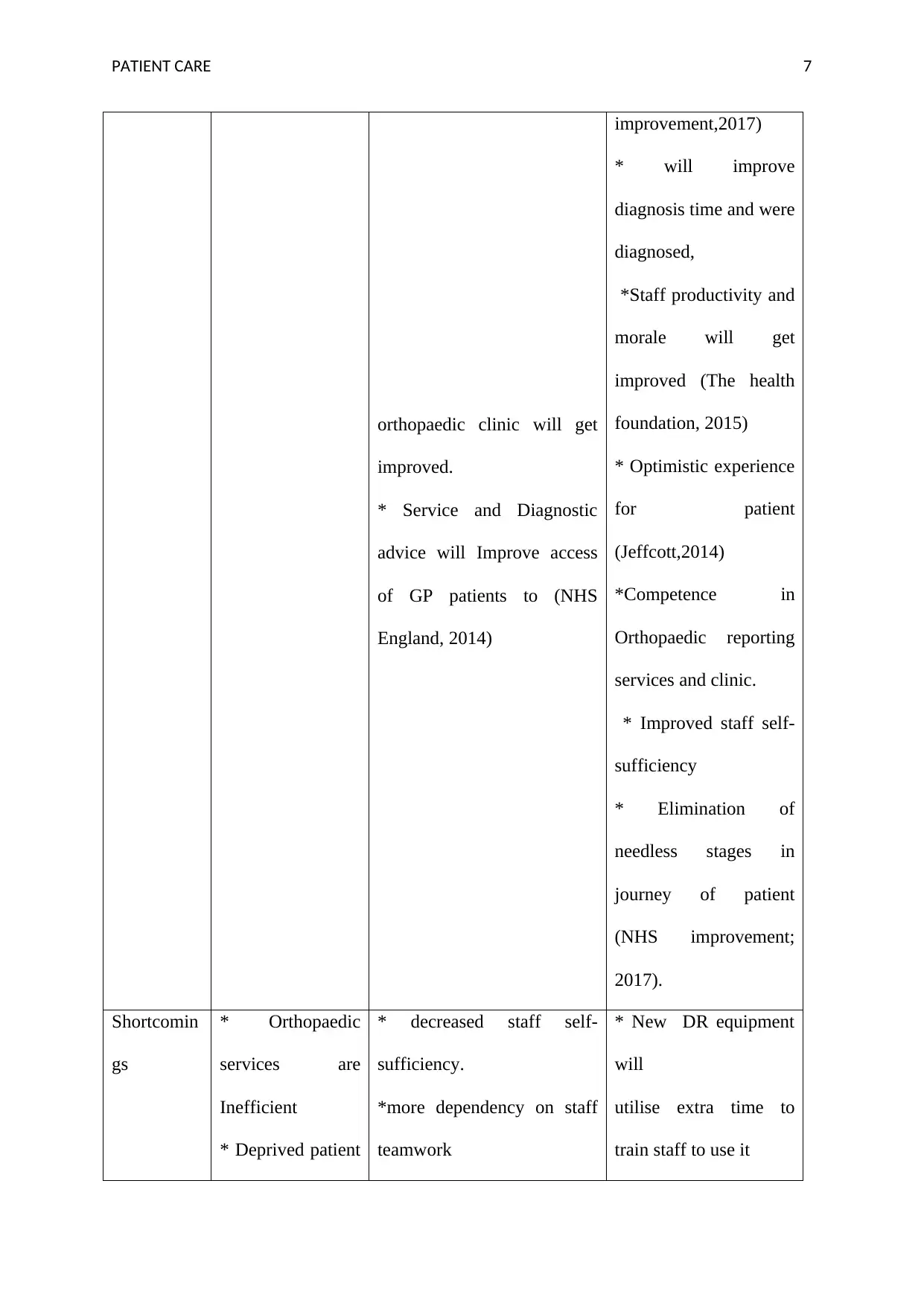
PATIENT CARE 7
orthopaedic clinic will get
improved.
* Service and Diagnostic
advice will Improve access
of GP patients to (NHS
England, 2014)
improvement,2017)
* will improve
diagnosis time and were
diagnosed,
*Staff productivity and
morale will get
improved (The health
foundation, 2015)
* Optimistic experience
for patient
(Jeffcott,2014)
*Competence in
Orthopaedic reporting
services and clinic.
* Improved staff self-
sufficiency
* Elimination of
needless stages in
journey of patient
(NHS improvement;
2017).
Shortcomin
gs
* Orthopaedic
services are
Inefficient
* Deprived patient
* decreased staff self-
sufficiency.
*more dependency on staff
teamwork
* New DR equipment
will
utilise extra time to
train staff to use it
orthopaedic clinic will get
improved.
* Service and Diagnostic
advice will Improve access
of GP patients to (NHS
England, 2014)
improvement,2017)
* will improve
diagnosis time and were
diagnosed,
*Staff productivity and
morale will get
improved (The health
foundation, 2015)
* Optimistic experience
for patient
(Jeffcott,2014)
*Competence in
Orthopaedic reporting
services and clinic.
* Improved staff self-
sufficiency
* Elimination of
needless stages in
journey of patient
(NHS improvement;
2017).
Shortcomin
gs
* Orthopaedic
services are
Inefficient
* Deprived patient
* decreased staff self-
sufficiency.
*more dependency on staff
teamwork
* New DR equipment
will
utilise extra time to
train staff to use it
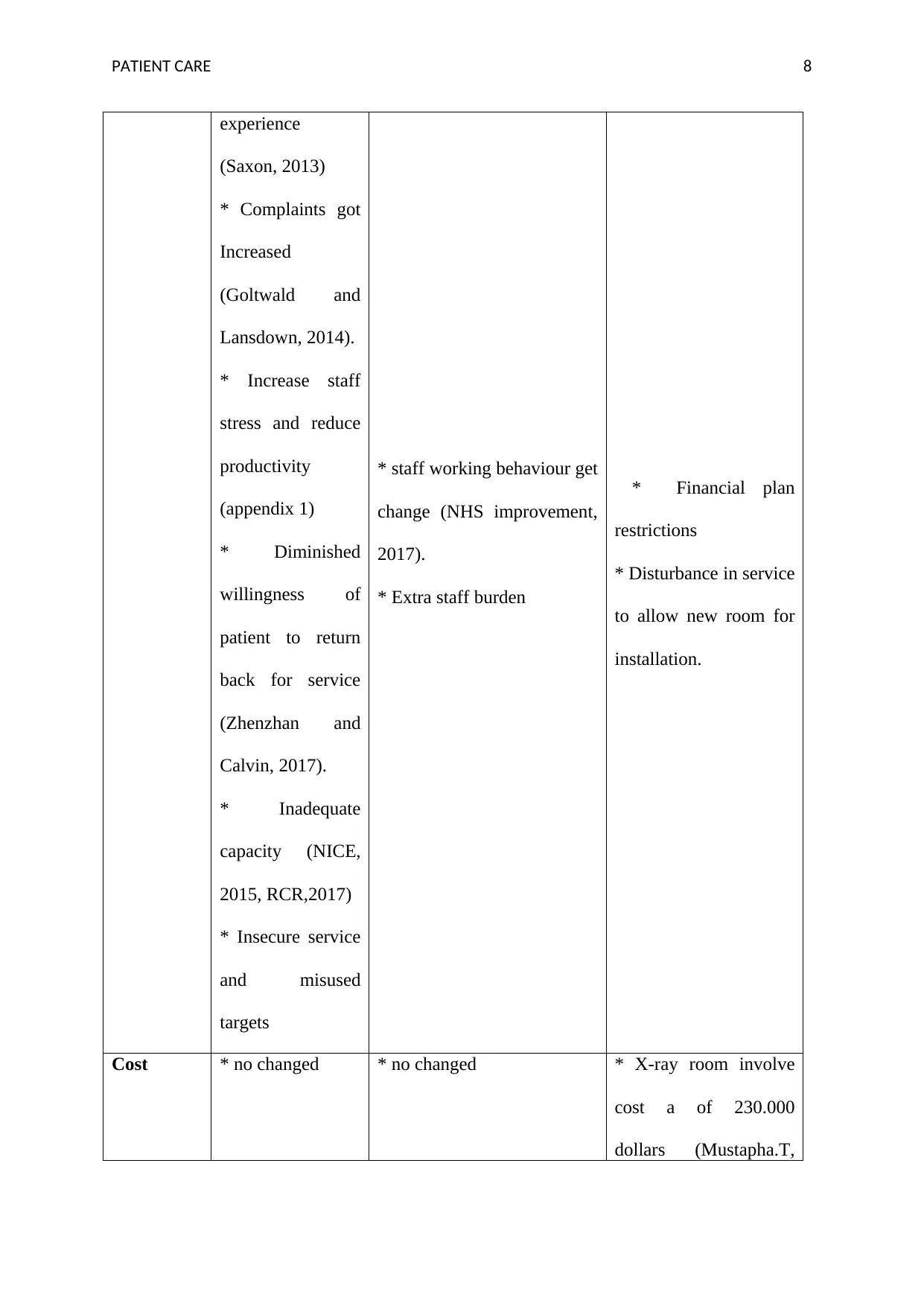
PATIENT CARE 8
experience
(Saxon, 2013)
* Complaints got
Increased
(Goltwald and
Lansdown, 2014).
* Increase staff
stress and reduce
productivity
(appendix 1)
* Diminished
willingness of
patient to return
back for service
(Zhenzhan and
Calvin, 2017).
* Inadequate
capacity (NICE,
2015, RCR,2017)
* Insecure service
and misused
targets
* staff working behaviour get
change (NHS improvement,
2017).
* Extra staff burden
* Financial plan
restrictions
* Disturbance in service
to allow new room for
installation.
Cost * no changed * no changed * X-ray room involve
cost a of 230.000
dollars (Mustapha.T,
experience
(Saxon, 2013)
* Complaints got
Increased
(Goltwald and
Lansdown, 2014).
* Increase staff
stress and reduce
productivity
(appendix 1)
* Diminished
willingness of
patient to return
back for service
(Zhenzhan and
Calvin, 2017).
* Inadequate
capacity (NICE,
2015, RCR,2017)
* Insecure service
and misused
targets
* staff working behaviour get
change (NHS improvement,
2017).
* Extra staff burden
* Financial plan
restrictions
* Disturbance in service
to allow new room for
installation.
Cost * no changed * no changed * X-ray room involve
cost a of 230.000
dollars (Mustapha.T,
⊘ This is a preview!⊘
Do you want full access?
Subscribe today to unlock all pages.

Trusted by 1+ million students worldwide
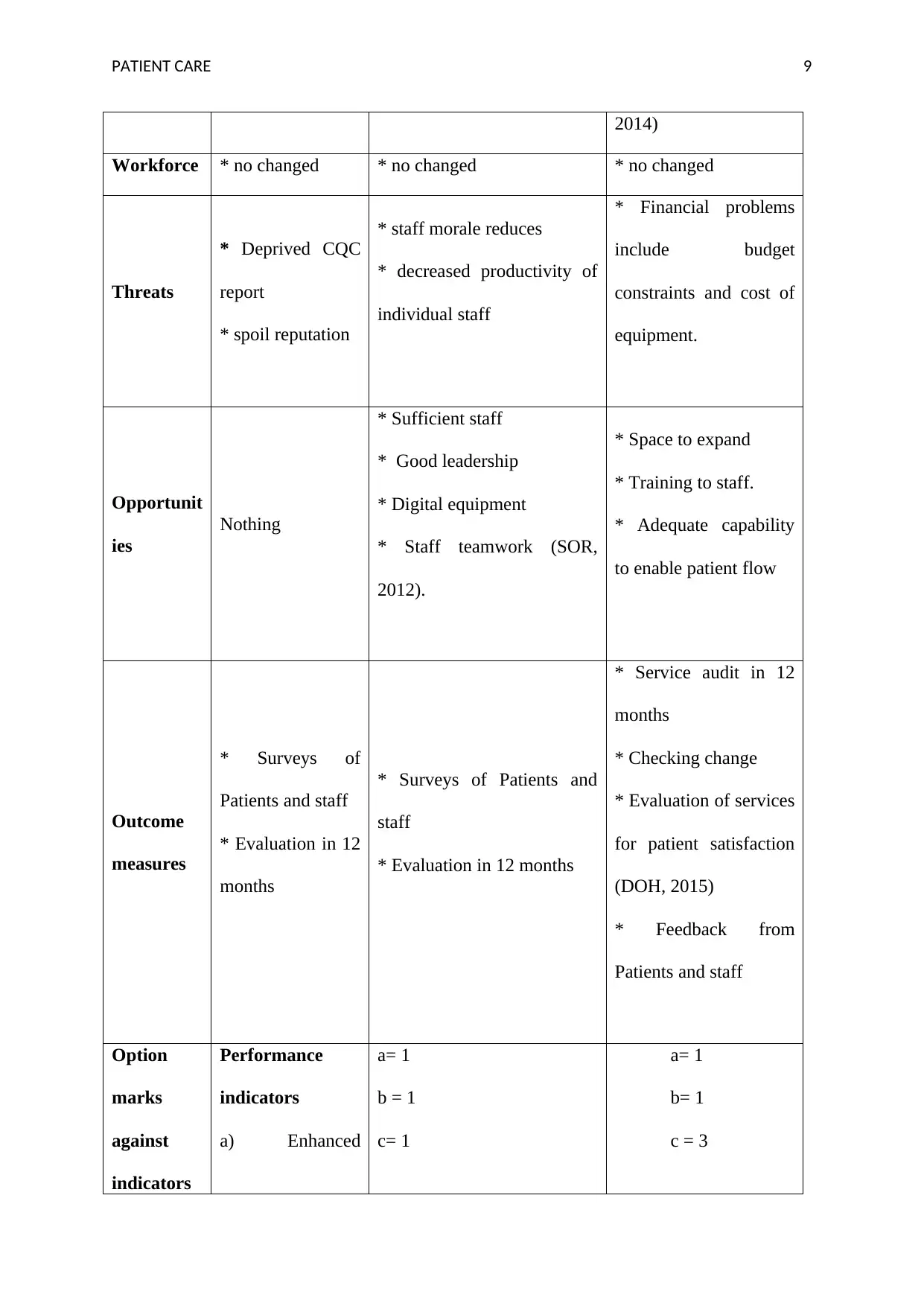
PATIENT CARE 9
2014)
Workforce * no changed * no changed * no changed
Threats
* Deprived CQC
report
* spoil reputation
* staff morale reduces
* decreased productivity of
individual staff
* Financial problems
include budget
constraints and cost of
equipment.
Opportunit
ies
Nothing
* Sufficient staff
* Good leadership
* Digital equipment
* Staff teamwork (SOR,
2012).
* Space to expand
* Training to staff.
* Adequate capability
to enable patient flow
Outcome
measures
* Surveys of
Patients and staff
* Evaluation in 12
months
* Surveys of Patients and
staff
* Evaluation in 12 months
* Service audit in 12
months
* Checking change
* Evaluation of services
for patient satisfaction
(DOH, 2015)
* Feedback from
Patients and staff
Option
marks
against
indicators
Performance
indicators
a) Enhanced
a= 1
b = 1
c= 1
a= 1
b= 1
c = 3
2014)
Workforce * no changed * no changed * no changed
Threats
* Deprived CQC
report
* spoil reputation
* staff morale reduces
* decreased productivity of
individual staff
* Financial problems
include budget
constraints and cost of
equipment.
Opportunit
ies
Nothing
* Sufficient staff
* Good leadership
* Digital equipment
* Staff teamwork (SOR,
2012).
* Space to expand
* Training to staff.
* Adequate capability
to enable patient flow
Outcome
measures
* Surveys of
Patients and staff
* Evaluation in 12
months
* Surveys of Patients and
staff
* Evaluation in 12 months
* Service audit in 12
months
* Checking change
* Evaluation of services
for patient satisfaction
(DOH, 2015)
* Feedback from
Patients and staff
Option
marks
against
indicators
Performance
indicators
a) Enhanced
a= 1
b = 1
c= 1
a= 1
b= 1
c = 3
Paraphrase This Document
Need a fresh take? Get an instant paraphrase of this document with our AI Paraphraser
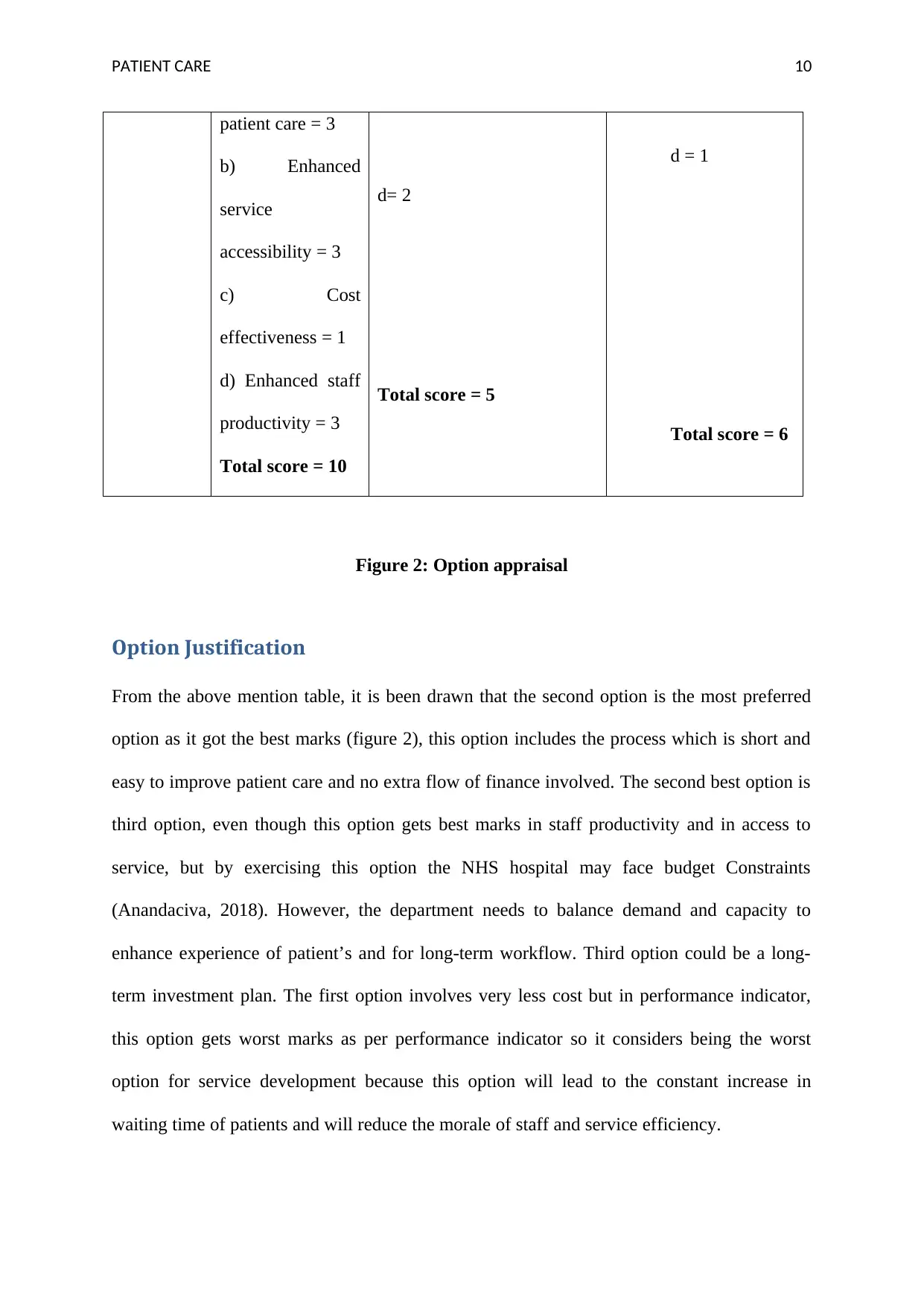
PATIENT CARE 10
patient care = 3
b) Enhanced
service
accessibility = 3
c) Cost
effectiveness = 1
d) Enhanced staff
productivity = 3
Total score = 10
d= 2
Total score = 5
d = 1
Total score = 6
Figure 2: Option appraisal
Option Justification
From the above mention table, it is been drawn that the second option is the most preferred
option as it got the best marks (figure 2), this option includes the process which is short and
easy to improve patient care and no extra flow of finance involved. The second best option is
third option, even though this option gets best marks in staff productivity and in access to
service, but by exercising this option the NHS hospital may face budget Constraints
(Anandaciva, 2018). However, the department needs to balance demand and capacity to
enhance experience of patient’s and for long-term workflow. Third option could be a long-
term investment plan. The first option involves very less cost but in performance indicator,
this option gets worst marks as per performance indicator so it considers being the worst
option for service development because this option will lead to the constant increase in
waiting time of patients and will reduce the morale of staff and service efficiency.
patient care = 3
b) Enhanced
service
accessibility = 3
c) Cost
effectiveness = 1
d) Enhanced staff
productivity = 3
Total score = 10
d= 2
Total score = 5
d = 1
Total score = 6
Figure 2: Option appraisal
Option Justification
From the above mention table, it is been drawn that the second option is the most preferred
option as it got the best marks (figure 2), this option includes the process which is short and
easy to improve patient care and no extra flow of finance involved. The second best option is
third option, even though this option gets best marks in staff productivity and in access to
service, but by exercising this option the NHS hospital may face budget Constraints
(Anandaciva, 2018). However, the department needs to balance demand and capacity to
enhance experience of patient’s and for long-term workflow. Third option could be a long-
term investment plan. The first option involves very less cost but in performance indicator,
this option gets worst marks as per performance indicator so it considers being the worst
option for service development because this option will lead to the constant increase in
waiting time of patients and will reduce the morale of staff and service efficiency.
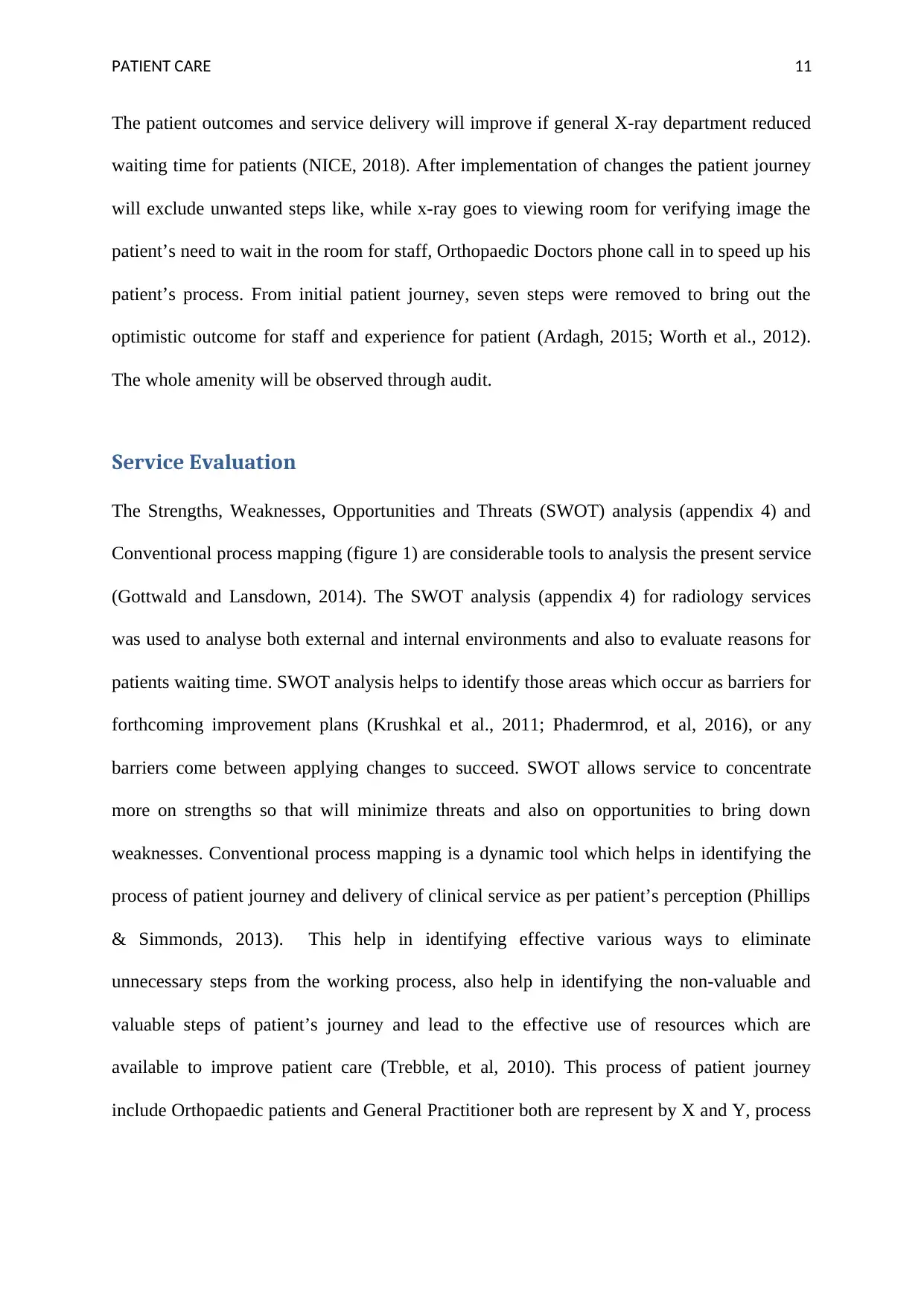
PATIENT CARE 11
The patient outcomes and service delivery will improve if general X-ray department reduced
waiting time for patients (NICE, 2018). After implementation of changes the patient journey
will exclude unwanted steps like, while x-ray goes to viewing room for verifying image the
patient’s need to wait in the room for staff, Orthopaedic Doctors phone call in to speed up his
patient’s process. From initial patient journey, seven steps were removed to bring out the
optimistic outcome for staff and experience for patient (Ardagh, 2015; Worth et al., 2012).
The whole amenity will be observed through audit.
Service Evaluation
The Strengths, Weaknesses, Opportunities and Threats (SWOT) analysis (appendix 4) and
Conventional process mapping (figure 1) are considerable tools to analysis the present service
(Gottwald and Lansdown, 2014). The SWOT analysis (appendix 4) for radiology services
was used to analyse both external and internal environments and also to evaluate reasons for
patients waiting time. SWOT analysis helps to identify those areas which occur as barriers for
forthcoming improvement plans (Krushkal et al., 2011; Phadermrod, et al, 2016), or any
barriers come between applying changes to succeed. SWOT allows service to concentrate
more on strengths so that will minimize threats and also on opportunities to bring down
weaknesses. Conventional process mapping is a dynamic tool which helps in identifying the
process of patient journey and delivery of clinical service as per patient’s perception (Phillips
& Simmonds, 2013). This help in identifying effective various ways to eliminate
unnecessary steps from the working process, also help in identifying the non-valuable and
valuable steps of patient’s journey and lead to the effective use of resources which are
available to improve patient care (Trebble, et al, 2010). This process of patient journey
include Orthopaedic patients and General Practitioner both are represent by X and Y, process
The patient outcomes and service delivery will improve if general X-ray department reduced
waiting time for patients (NICE, 2018). After implementation of changes the patient journey
will exclude unwanted steps like, while x-ray goes to viewing room for verifying image the
patient’s need to wait in the room for staff, Orthopaedic Doctors phone call in to speed up his
patient’s process. From initial patient journey, seven steps were removed to bring out the
optimistic outcome for staff and experience for patient (Ardagh, 2015; Worth et al., 2012).
The whole amenity will be observed through audit.
Service Evaluation
The Strengths, Weaknesses, Opportunities and Threats (SWOT) analysis (appendix 4) and
Conventional process mapping (figure 1) are considerable tools to analysis the present service
(Gottwald and Lansdown, 2014). The SWOT analysis (appendix 4) for radiology services
was used to analyse both external and internal environments and also to evaluate reasons for
patients waiting time. SWOT analysis helps to identify those areas which occur as barriers for
forthcoming improvement plans (Krushkal et al., 2011; Phadermrod, et al, 2016), or any
barriers come between applying changes to succeed. SWOT allows service to concentrate
more on strengths so that will minimize threats and also on opportunities to bring down
weaknesses. Conventional process mapping is a dynamic tool which helps in identifying the
process of patient journey and delivery of clinical service as per patient’s perception (Phillips
& Simmonds, 2013). This help in identifying effective various ways to eliminate
unnecessary steps from the working process, also help in identifying the non-valuable and
valuable steps of patient’s journey and lead to the effective use of resources which are
available to improve patient care (Trebble, et al, 2010). This process of patient journey
include Orthopaedic patients and General Practitioner both are represent by X and Y, process
⊘ This is a preview!⊘
Do you want full access?
Subscribe today to unlock all pages.

Trusted by 1+ million students worldwide
1 out of 16
Related Documents
Your All-in-One AI-Powered Toolkit for Academic Success.
+13062052269
info@desklib.com
Available 24*7 on WhatsApp / Email
![[object Object]](/_next/static/media/star-bottom.7253800d.svg)
Unlock your academic potential
Copyright © 2020–2025 A2Z Services. All Rights Reserved. Developed and managed by ZUCOL.





